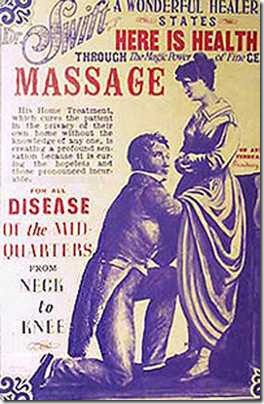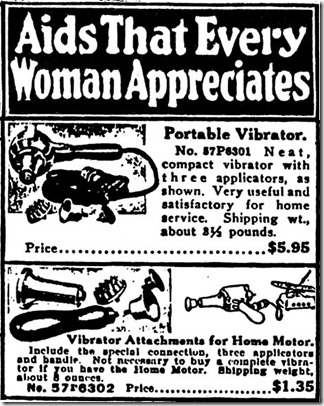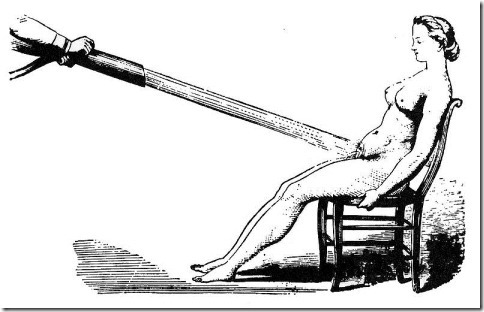 Vibrators replaced power douches and doctor’s finger stimulation as treatment for female hysteria
Vibrators replaced power douches and doctor’s finger stimulation as treatment for female hysteria
Pelvic Massage
By the mid to late 19th century, hysteria (or sometimes female hysteria) came to refer to what is today generally considered to be sexual dysfunction. Typical treatment was massage of the patient’s genitalia by the physician and, later, by vibrators or water sprays to cause orgasm.
Female Hysteria
Female hysteria is a common medical diagnosis, made exclusively in women, which is today rarely recognized by modern medical authorities as a medical disorder. Its diagnosis and treatment were routine for many hundreds of years in Western Europe. Hysteria was widely discussed in the medical literature of the 19th century. Women considered to be suffering from it exhibited a wide array of symptoms including faintness, nervousness, insomnia, fluid retention, heaviness in abdomen, muscle spasm, shortness of breath, irritability, loss of appetite for food or sex, and “a tendency to cause trouble”.
“Hysterical Paroxysm” (orgasm).
Since ancient times women considered to be suffering from hysteria would sometimes undergo “pelvic massage” — manual stimulation of the genitals by the doctor until the patient experienced “hysterical paroxysm” (orgasm).
Vibrators, water jets …, the technology of orgasm
 Vibrators replaced power douches and doctor’s finger stimulation as treatment for female hysteria
Vibrators replaced power douches and doctor’s finger stimulation as treatment for female hysteria
Pelvic Massage
By the mid to late 19th century, hysteria (or sometimes female hysteria) came to refer to what is today generally considered to be sexual dysfunction. Typical treatment was massage of the patient’s genitalia by the physician and, later, by vibrators or water sprays to cause orgasm.
Female Hysteria
Female hysteria is a common medical diagnosis, made exclusively in women, which is today rarely recognized by modern medical authorities as a medical disorder. Its diagnosis and treatment were routine for many hundreds of years in Western Europe. Hysteria was widely discussed in the medical literature of the 19th century. Women considered to be suffering from it exhibited a wide array of symptoms including faintness, nervousness, insomnia, fluid retention, heaviness in abdomen, muscle spasm, shortness of breath, irritability, loss of appetite for food or sex, and “a tendency to cause trouble”.
“Hysterical Paroxysm” (orgasm).
Since ancient times women considered to be suffering from hysteria would sometimes undergo “pelvic massage” — manual stimulation of the genitals by the doctor until the patient experienced “hysterical paroxysm” (orgasm).
Vibrators, water jets …, the technology of orgasm
 Vibrators replaced power douches and doctor’s finger stimulation as treatment for female hysteria
Vibrators replaced power douches and doctor’s finger stimulation as treatment for female hysteria
Pelvic Massage
By the mid to late 19th century, hysteria (or sometimes female hysteria) came to refer to what is today generally considered to be sexual dysfunction. Typical treatment was massage of the patient’s genitalia by the physician and, later, by vibrators or water sprays to cause orgasm.
Female Hysteria
Female hysteria is a common medical diagnosis, made exclusively in women, which is today rarely recognized by modern medical authorities as a medical disorder. Its diagnosis and treatment were routine for many hundreds of years in Western Europe. Hysteria was widely discussed in the medical literature of the 19th century. Women considered to be suffering from it exhibited a wide array of symptoms including faintness, nervousness, insomnia, fluid retention, heaviness in abdomen, muscle spasm, shortness of breath, irritability, loss of appetite for food or sex, and “a tendency to cause trouble”.
“Hysterical Paroxysm” (orgasm).
Since ancient times women considered to be suffering from hysteria would sometimes undergo “pelvic massage” — manual stimulation of the genitals by the doctor until the patient experienced “hysterical paroxysm” (orgasm).
Vibrators, water jets …, the technology of orgasm
 Vibrators replaced power douches and doctor’s finger stimulation as treatment for female hysteria
Vibrators replaced power douches and doctor’s finger stimulation as treatment for female hysteria
Pelvic Massage
By the mid to late 19th century, hysteria (or sometimes female hysteria) came to refer to what is today generally considered to be sexual dysfunction. Typical treatment was massage of the patient’s genitalia by the physician and, later, by vibrators or water sprays to cause orgasm.
Female Hysteria
Female hysteria is a common medical diagnosis, made exclusively in women, which is today rarely recognized by modern medical authorities as a medical disorder. Its diagnosis and treatment were routine for many hundreds of years in Western Europe. Hysteria was widely discussed in the medical literature of the 19th century. Women considered to be suffering from it exhibited a wide array of symptoms including faintness, nervousness, insomnia, fluid retention, heaviness in abdomen, muscle spasm, shortness of breath, irritability, loss of appetite for food or sex, and “a tendency to cause trouble”.
“Hysterical Paroxysm” (orgasm).
Since ancient times women considered to be suffering from hysteria would sometimes undergo “pelvic massage” — manual stimulation of the genitals by the doctor until the patient experienced “hysterical paroxysm” (orgasm).
Vibrators, water jets …, the technology of orgasm
 Vibrators replaced power douches and doctor’s finger stimulation as treatment for female hysteria
Vibrators replaced power douches and doctor’s finger stimulation as treatment for female hysteria
Pelvic Massage
By the mid to late 19th century, hysteria (or sometimes female hysteria) came to refer to what is today generally considered to be sexual dysfunction. Typical treatment was massage of the patient’s genitalia by the physician and, later, by vibrators or water sprays to cause orgasm.
Female Hysteria
Female hysteria is a common medical diagnosis, made exclusively in women, which is today rarely recognized by modern medical authorities as a medical disorder. Its diagnosis and treatment were routine for many hundreds of years in Western Europe. Hysteria was widely discussed in the medical literature of the 19th century. Women considered to be suffering from it exhibited a wide array of symptoms including faintness, nervousness, insomnia, fluid retention, heaviness in abdomen, muscle spasm, shortness of breath, irritability, loss of appetite for food or sex, and “a tendency to cause trouble”.
“Hysterical Paroxysm” (orgasm).
Since ancient times women considered to be suffering from hysteria would sometimes undergo “pelvic massage” — manual stimulation of the genitals by the doctor until the patient experienced “hysterical paroxysm” (orgasm).
Vibrators, water jets …, the technology of orgasm
 Vibrators replaced power douches and doctor’s finger stimulation as treatment for female hysteria
Vibrators replaced power douches and doctor’s finger stimulation as treatment for female hysteria
Pelvic Massage
By the mid to late 19th century, hysteria (or sometimes female hysteria) came to refer to what is today generally considered to be sexual dysfunction. Typical treatment was massage of the patient’s genitalia by the physician and, later, by vibrators or water sprays to cause orgasm.
Female Hysteria
Female hysteria is a common medical diagnosis, made exclusively in women, which is today rarely recognized by modern medical authorities as a medical disorder. Its diagnosis and treatment were routine for many hundreds of years in Western Europe. Hysteria was widely discussed in the medical literature of the 19th century. Women considered to be suffering from it exhibited a wide array of symptoms including faintness, nervousness, insomnia, fluid retention, heaviness in abdomen, muscle spasm, shortness of breath, irritability, loss of appetite for food or sex, and “a tendency to cause trouble”.
“Hysterical Paroxysm” (orgasm).
Since ancient times women considered to be suffering from hysteria would sometimes undergo “pelvic massage” — manual stimulation of the genitals by the doctor until the patient experienced “hysterical paroxysm” (orgasm).
Vibrators, water jets …, the technology of orgasm
 Vibrators replaced power douches and doctor’s finger stimulation as treatment for female hysteria
Vibrators replaced power douches and doctor’s finger stimulation as treatment for female hysteria
Pelvic Massage
By the mid to late 19th century, hysteria (or sometimes female hysteria) came to refer to what is today generally considered to be sexual dysfunction. Typical treatment was massage of the patient’s genitalia by the physician and, later, by vibrators or water sprays to cause orgasm.
Female Hysteria
Female hysteria is a common medical diagnosis, made exclusively in women, which is today rarely recognized by modern medical authorities as a medical disorder. Its diagnosis and treatment were routine for many hundreds of years in Western Europe. Hysteria was widely discussed in the medical literature of the 19th century. Women considered to be suffering from it exhibited a wide array of symptoms including faintness, nervousness, insomnia, fluid retention, heaviness in abdomen, muscle spasm, shortness of breath, irritability, loss of appetite for food or sex, and “a tendency to cause trouble”.
“Hysterical Paroxysm” (orgasm).
Since ancient times women considered to be suffering from hysteria would sometimes undergo “pelvic massage” — manual stimulation of the genitals by the doctor until the patient experienced “hysterical paroxysm” (orgasm).
Vibrators, water jets …, the technology of orgasm
Wait, there is more! This article continues! Continue reading “The history of vibrators: (1) orgasms as medical therapy for hysteria” »
The history of vibrators: (1) orgasms as medical therapy for hyste…
» continues here »

 Millennia of medical orgasm induction, and it all stayed below the radar and remained quite unknown.
Millennia of medical orgasm induction, and it all stayed below the radar and remained quite unknown. 